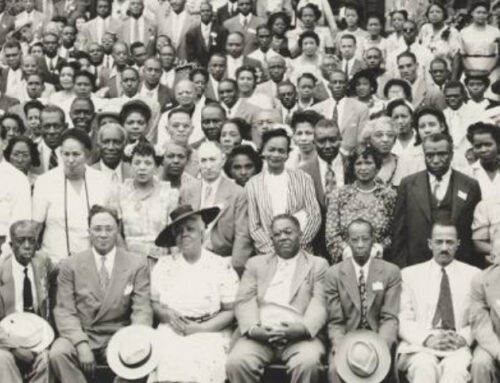Today an update about the organizing working on healing slavery’s wounds Coming to the Table.
Have you found enslaved people in your family tree or discovered enslavers among your ancestors? In 2006, Coming to the Table (CTTT) was launched when people “whose ancestors were connected through an enslaved/enslaver relationship realized they had a shared story that remained untold.”Happily, since I first wrote about this organization in 2013, CTTT’s mission, resources, and outreach have expanded. Today, CTTT is a program of RJOY, Restorative Justice for Oakland Youth.
The Origins of Coming to the Table

Participants in the 2014 CTTT conference connected with each other in extended conversations. (Photo by Tom DeWolf, courtesy Coming to the Table)
In January of 2006, “black and white descendants of ancestors linked by a slave/slave-owner relationship, a blood connection, or both came together in a small retreat which took place at Eastern Mennonite University in Harrisonburg, Virginia, to explore the history of slavery—its legacy and impact on their lives today. ”
Early efforts included support for the Slave Dwelling Project led by Joseph McGill. Several members presented the CTTT story nationally and locally from both sides of the racial divide as Betty Kilby Baldwin and Phoebe Kilby have done. CTTT also inspired the book Gather at the Table (Beacon Press, 2012), which 2012 Nobel Peace Laureate Leymah Gbowee calls “an honest exploration into the deep social wounds left by racism, violence and injustice.”
Current Work on Healing Slavery’s Wounds Coming to the Table
Even as that first group met 14 years ago, they had a longer-term goal. Could a model be created to help heal and guide individuals and groups that continue to struggle with racism in the United States and throughout the world? The answer lies in the CTTT approach.
The model “for this vision and mission is grounded in theories and practices of Strategies for Trauma Awareness & Resilience (STAR), with a particular focus on Transforming Historical Harms and their trans-generational transmission, working toward racial justice and equity through a Restorative lens, and utilizing Circle Process and Touchstones to create space in which participants feel safe enough, and motivated, to do the work.”
Read more about CTTT Approach, involving four interrelated practices:
- Uncovering History: researching, acknowledging, and sharing personal, family, community, state, and national histories of race with openness and honesty
- Making Connections: connecting to others within and across racial lines in order to develop and deepen relationships
- Working Toward Healing: exploring how we can heal together through dialogue, reunion, ritual, meditation, prayer, ceremony, the arts, apology and other methods
- Taking Action: actively seeking to dismantle systems of racial inequality, injustice, and oppression; to work for the transformation of our nation.
Coming to the Table Resources:
Confronting Slavery in Your Family’s History
by Susan Hutchison
Contacting ‘Linked Descendants’
Genealogy: Researching Your Family History
Researching African American Family History
by Patricia Moncure Thomas
Resources For Researching Your Family History
Researching Slave Holding and Slave Trading Ancestry
by Rev. David Pettee
Read more about African American genealogy resources at:
http://www.comingtothetable.org/resources/
Consider becoming a member to advance the work healing slavery’s wounds Coming to the Table.
For more posts about African American genealogy research, click here.





kin, I’ve read Ball’s book, but I thought it was badly flawed and I hope a more talented author takes on the same topic soon. Ball is so intrusive and constantly abjures the reader to feelings that they could easily reach on their own if he’s just step back a bit. And I find it frankly unbelievable that he goes to a single meeting of a Harlem genealogical society and out of the dozen people there, one is a descendant of slaves from his family’s plantations.
Thanks for posting this! I would have missed it if you hadn’t posted it. Related to this story would be the book “Slaves In the Family” by Edward Ball. While you won’t get research links or places to go with this book it is a truly captivating story. Here’s the link from Amazon: http://www.amazon.com/Slaves-Family-Edward-Ball/dp/0345431057
Thanks for providing a link to the article in “People”. I usually only read it at the hair salon, and I’ll still look for it there because all the 20-something hair stylists are in LOVE with the TV show WDYTYA. They’ll love the link and they’ll be picking my brains about their own family trees again when they see this!